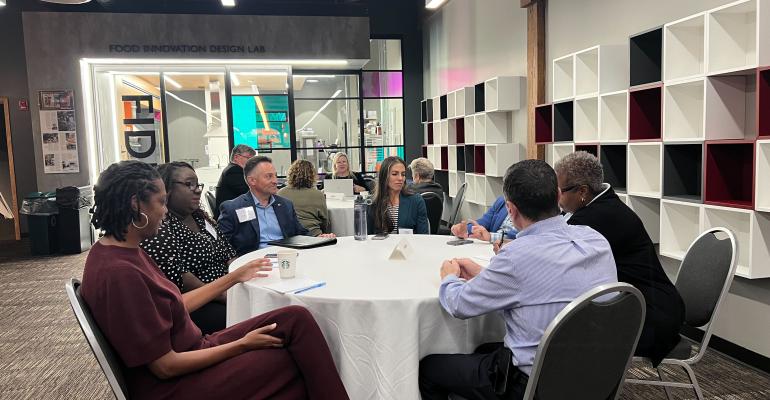At Nation’s Restaurant News’ annual Food Safety Symposium sponsored by Ecolab, held this year on Oct. 10 and 11 at Johnson and Wales University in Providence, Rhode Island, food safety leaders from 17 different major restaurant chains and hospitality companies across the U.S. came together to discuss the current and future state of the food safety industry in a post-pandemic world.
As the restaurant industry has largely gotten back to normal, vigilance toward food safety issues is paramount, especially with new allergens and foodborne illness risks being discovered, as well as the navigation of staffing, funding, and educational hurdles toward achieving a healthier environment for foodservice professionals.
“Food safety is a foundation, not a priority, because priorities change,” Mitzi Baum, CEO of Stop Foodborne Illness said during the first session at the 2023 Food Safety Symposium.
Here are some of the major takeaways from the Food Safety Symposium event.
Food safety experts should pay attention to sustainability trends
For proof that food safety professionals should keep tabs on larger foodservice trends as a whole outside the immediate world of inspections, pathogens, and contaminants, Lisa Robinson, vice president of global food safety and public health for Ecolab pointed to the proliferation of reusable container programs across the restaurant industry as a sustainability trend on the rise.
“How can we bring those [containers] in and what is the cocktail of allergens in them?,” she asked. “We would want to test those products after cleaning them…when you think about returning a reusable container, you’d want to make sure that it's really clean.”
Robinson said that Ecolab is in the midst of developing and validating new testing processes to make sure that reusable containers are as safe and clean as possible.
Accountability should be shared, from management to the c-suite
During the “Building the Business Case for Your Food Safety Program” segment of the symposium, Mandy Sedlak presented data from a study as part of the Retail Food Safety Regulatory Association Collaborative Action Plan, which surveyed 118 foodservice and retail operators. One of the biggest takeaways was a uniform lack of shared accountability throughout a restaurant organization, from the c-suite down to the managers. According to the survey, only 16% of operators said that their managers always model correct behavior for employees, and almost one-third of respondents said that senior management in the c-suite lacked shared accountability of food safety practices.
A possible solution for this? Have food safety metrics tied to performance bonuses at the leadership level, where other factors like diversity and sustainability are already taken into account. For lower-level employees, possible incentives could include contests with cash prizes, Sedlak suggested.
“Everyone is motivated differently,” she said.
It is crucial to develop relationships with regulatory authorities
Another important takeaway from the survey is how important it is to have a good relationship with inspectors and other local and federal-level food safety authorities. According to the survey, 43% of restaurant brands said that they are not engaged with their local regulatory authorities.
“That proactive relationship is so important,” Sedlak said. “One of the most captivating discoveries to emerge out of the survey was the importance between the relationship building between the regulated industry and the regulatory authority.”
These responses go hand-in-hand with other survey data that showed that about one-quarter of respondents were unsatisfied with how developed their food safety programs were.
Traceability is changing food safety forever
During the “Traceability and Other Trends” education session, Dr. Ben Miller, executive vice president of scientific and regulatory affairs with the Acheson Group spoke about the Food Safety Modernization Act, which was passed in 2011 and includes a traceability compliance rule that will go into effect in June 2026. By that point, restaurants will have to follow a new set of rules to track certain high-risk food ingredients along the supply chain in order to help experts trace back the source of any future foodborne illness outbreaks. This list of high-risk ingredients includes fresh fruits and vegetables, eggs, nut butters, cheeses, and seafood products.
“Traceability is really about investigators trying to determine the source of an outbreak,” Dr. Miller said. “You might start with a scenario where you have multiple people infected and multiple restaurant locations, so what the investigators are looking for is the point of convergence, within the supply chain. They’re trying to trace it back and [in a restaurant dish] you have to look at multiple ingredients, like lettuce, tomatoes, cilantro, white and green onions. Any one of those could potentially be associated with illness.”
The entire supply chain needs to be educated
Besides complying with the new regulatory standards, how can restaurant operators get involved with improving traceability standards? By educating their suppliers.
“I would be thinking about ‘how do I educate those suppliers to give me the data in the way that I want to receive it?’” Dr. Miller said. “If you haven't thought about this yet, think about who you need on your team to start building out these systems, because… the reality is, this is not a problem that you can solve it on your own. It's going to require logistics people in the supply chain thinking holistically and changing.”
Contact Joanna at [email protected]





